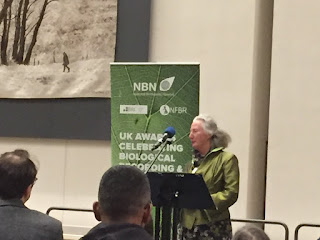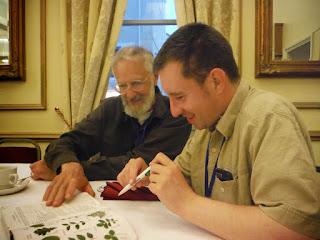 |
| Monica's exhibit at the AEM Image: R. Horton |
"I didn't think I had time to put together a display for the AEM this year but then I remembered an idea I'd had for a photoguide to basal rosettes. Some species of plants, such as many of the thistles, have very obvious and often distinctive basal rosettes, but these are rarely illustrated in the field guides. So I thought I should photograph them and perhaps build up a collection showing typical rosettes of common plants.
"About a week before the
AEM I sat down at my computer and started going through my photos of plants.
The result was a small display showing basal rosettes of four species of
thistle: Stemless Thistle Cirsium acaule, Woolly Thistle C. eriophorum, Marsh Thistle C. palustre and Spear Thistle C. vulgare. Then I added some notes comparing the last three, and
put them out on a table at the Centre for Ecology and Hydrology.
I'd also got a photo of a Dandelion (Taraxacum agg.) and Fox
and Cubs (Pilosella aurantiaca) and some notes on other plants with basal
rosettes – most of the British species of Plantain, some crucifers, the
Primulas – but I didn't have space to display them.
My display generated some interest so now I'm thinking about
how to take further 'Monica's guide to basal rosettes'. Obviously I need more
photos – it was an omission not to include one of the commonest thistles, Creeping Thistle , Cirsium
arvense, but I didn't have any photos, and C. vulgare has completely different
first year rosettes.
 |
| Stemless Thistle aka Picnickers' Nightmare! Image courtesy of J. Crellin/Floral Images http://www.floralimages.co.uk/ page.php?taxon=cirsium_acaule,1 |
Perhaps I could see if the Field Studies Council would
like to publish a fold-out guide to basal rosettes. But should I limit it to
thistles? Or to Asteraceae? But I expect I'll be busy taking more photos and
perhaps there'll be a more comprehensive display for next year's AEM. Thanks to
everyone who commented on my display and made suggestions".
Many thanks to Monica for telling us about her exhibit - it will be interesting to see how 'Monica's guide to basal rosettes' develops. In the meantime, you can download the pdf here showing images of rosettes of Marsh, Woolly and Spear Thistles, and a table showing how to separate these three species.
Many thanks to Monica for telling us about her exhibit - it will be interesting to see how 'Monica's guide to basal rosettes' develops. In the meantime, you can download the pdf here showing images of rosettes of Marsh, Woolly and Spear Thistles, and a table showing how to separate these three species.





















